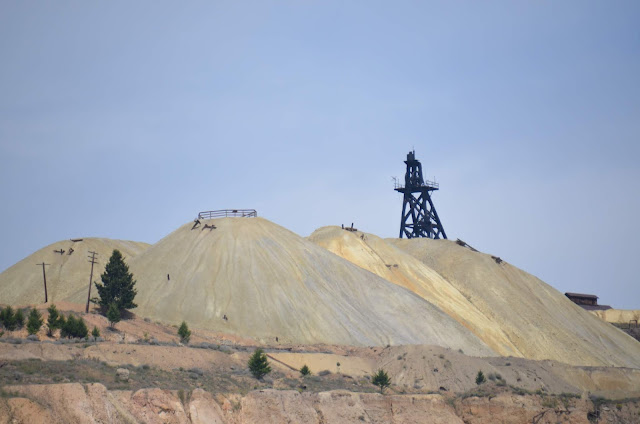We are now staying at an RV park right off of I-90, about 15 miles west of I-15, called Indian Creek RV Park. It is a great RV park, with lots of grass, full hook-ups and friendly staff. The only thing that has been a problem has been Wi-Fi. It has been pretty much non-existent until today, and finally, we have fast Wi-Fi!!! So I am going to do some blog catch up.
I want to start this post by saying that Montana was built on ranching and mining, and both are still going strong today.
When we headed to Butte, we didn't know what to expect. Everyone just kept telling us that we had to see it, and that it was a really interesting town. As we pulled into town, we really didn't understand the meaning of this sign, but we were hoping that by the end of the day we would have a better understanding.
Our first stop in Butte was the Berkeley Pit. It was the first surface copper mine in this area, and was mined from 1955-1982. It was $3.00 per person to enter the viewing platform for the old mine. There is a tunnel that runs under the tailings from the old mine that takes you to the platform.


According to the information provided at the viewing platform, when the pit closed, it was the largest truck operated open pit copper mine in the United States. It measures 7,000 feet long, 5,600 feet wide and approximately 1,800 feet deep. It's about 3 miles around the outside of the pit. Approximately 1.4 billion tons of ore was removed from this mine between 1955 and 1982. At one point, it provided 25% of the entire world's copper production. That's incredible when you think that was coming from one mine!
During the active mining years, the ground water was continuously pumped from the mine area, but once they stopped mining this sight, the ground water continued to flow into the mine, but was no longer pumped out. Because of all of the minerals that were disrupted during the mining process, this continuous water flow created a large lake contaminated with high levels of copper, cadmium, colbalt, iron, manganese and zinc. When they closed the mine, they predicted that the mine would reach it's critical water level in about 2018.
There is a water treatment facility on the far side of the pit, which is now treating water from this sight, for use in the new Continental Mine.

After the Berkeley Pit closed in 1982, mining was resurrected in 1986 at a sight called the Continental Pit, east of , and right next to the old mine. As we stood on the viewing platform of the Berkeley Pit, we heard constant alarms and blasts and trucks coming from the new copper mine right next door.
There were several other types of mining in Butte prior to the strip mining. The first mining operations started around 1864. So after leaving the Berkeley Pit sight, we began exploring the rest of the town, and very quickly discovered that towers from all of the old mines are scattered throughout the town.

The town of Butte is also the sight of a memorial for one of the largest mining disasters.
From this memorial, the views of the town are spectacular! It is ironic how the very thing that brought life to this town also took life and livelihood from so many of the people that depended on it.

Can you imagine that this mine reached clear back down to sea-level?
All over the town of Butte, there are these little placards explaining what you are looking at, which is a very unique way to learn about the history of a town.
The ore from the mines in Butte was shipped to a small, but once very prosperous town in Montana called Anaconda, approximately 20 miles away, where it was smelted and the copper was extracted.
The smelting tower still stands just outside of Anaconda, and at the base of it (although you can't see it in this picture), is a huge pile of black remains from the smelting process.
The city and county building of Anaconda.
And just behind the city and county building is the beautiful town cemetery, with so many graves from the 1800's, overlooking the town.






















No comments:
Post a Comment